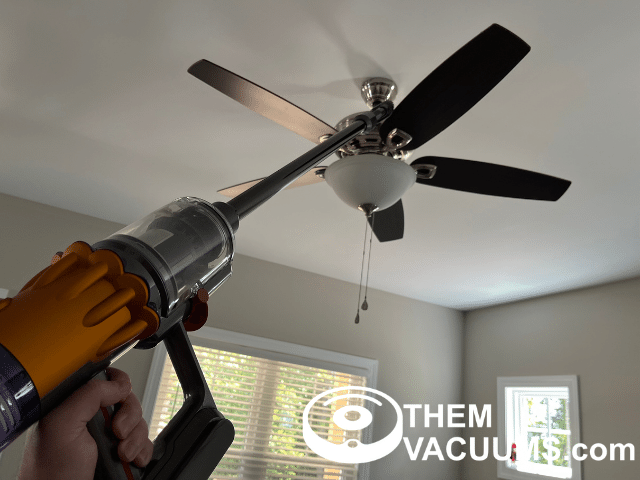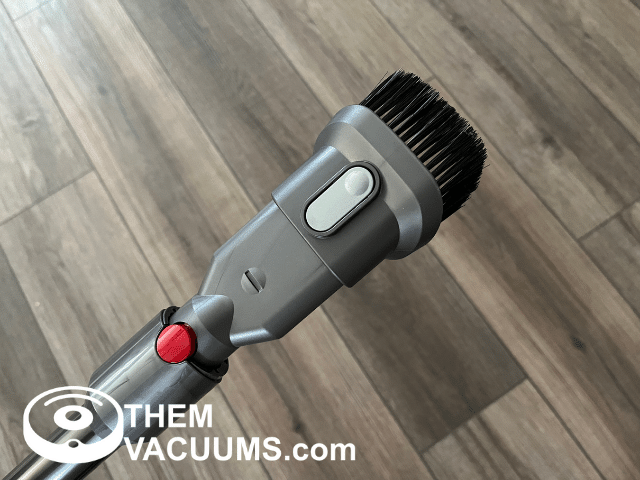
Ceiling fans have a knack for collecting dust like it’s their favorite hobby, and let’s be honest, cleaning them is a chore we’d rather avoid. But here’s the silver lining: your trusty vacuum cleaner can be your secret weapon in the battle against dusty fan blades!
Curious about which vacuum cleaner to enlist and looking for some pro tips to keep those fans from turning into dust magnets? Well, you’re in luck! In this post, we’ll go over the vacuum cleaner choices and share some genius hacks to prevent your fans from going dusty in the first place. Get ready to breeze through fan cleaning like a pro!
How To Clean Ceiling Fan With Vacuum Cleaner
Here are the steps to clean a ceiling fan with your vacuum cleaner.
- Turn the fan off and allow it to completely stop.
- Get your vacuum cleaner and add an extension or long hose attachment along with a small bristle brush.
- Turn the vacuum cleaner on and clean the fan blades first.
- Once the fan blades are cleaned, vacuum the base unit, it’s vents and around the lights to suck out the dust and spider webs that are hidden near the motor.
Do not use any water or chemical cleaners before vacuuming. Your regular vacuum cleaner can’t handle water or other chemicals, so don’t vacuum that up!
Best Vacuums For Ceiling Fans
The best vacuum cleaner to clean ceiling fans will be a stick style vacuum cleaner or one with a long handle attachment.
I, personally, use a Dyson v12 Detect Slim as it is lightweight and has the attachments I need to reach the fan. You don’t need to have this vacuum cleaner, any vacuum cleaner with a long reaching hose will work too.
A shop vacuum will also work and something every household should have. With their long hoses, long cords, and powerful suction, they can pick up many things you don’t want to with your regular vacuum cleaner.
(TIP) Use Pillowcase To Clean Ceiling Fan Blades!
Using a vacuum cleaner is great, but using a pillowcase to clean the ceiling fan blades is so much easier and quicker.
The pillowcase won’t clean the vents of the fan and get the finer details, but it’s the best for cleaning the fan blades of the ceiling fan!
Why Do Ceiling Fans Get So Dusty?
There are a few reasons why your ceiling fan may be getting dustier than usual.
One possibility is that the air in your home is more humid than usual, which can cause dust to stick to surfaces more easily.
Another possibility is that there has been construction or remodeling nearby, which can send dust particles into the air.
Finally, if you have pets, their shedding can also contribute to a dustier environment.
If you run your ceiling fan often or a lot, it may get more dirty than one that doesn’t run as much. This is because the fan is always moving air and stirring it up and collecting more dust.
Prevent Dust!
There are a few things you can do to help prevent your ceiling fan from getting too dusty.
One is to make sure that you dust other surfaces in your home regularly, as this will help reduce the overall amount of dust in the air. Keep doors and windows closed, especially in dusty areas or where there is new construction.
You can also invest in an air purifier, which can help remove dust particles from the air.
I use the Germ Guardian Air Purifier (Amazon Link Ad) for my home, and it really does help with the dust.
Finally, if you have pets, try to keep them groomed so that they shed less.
Don’t forget to check for areas of your home that may be more exposed to the outside. Cracks or damaged areas of your home could be letting in more dirt and dust into your home. Old windows, broken seals on doors and many other things can lead to you having more dust than usual in your home.
More great tips in this video:
One often overlooked option is to vacuum more. I know this is a chore, but a robot vacuum can help greatly to keep the dust down. Just check out how much dust and dirt we get from our Roomba.
